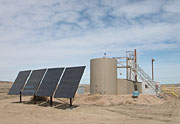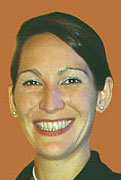| Research
|
|
|||||||||||||||||||||
|
Check out the Office of Science's new Website.
|
Solar technology applied to oil
|
 |
| Solar-powered pump station in Wyoming |
NREL and RMOTC began talking three years ago about using solar energy at its site in near Casper, Wyoming. Originally established by DOE as a testing alternative for the petroleum industry, RMOTC now offers a wide range of services to industries with testing and evaluation needs.
A solar-direct shipping pump system was selected for testing. The PV array provides electricity to a shipping pump which transfers the pumped oil from an intermediate collection point to a central collection point. When the sun shines, the oil is transferred.
"Moving oil from shipping tank to shipping tank is a necessary part of a large oil operation and energy is required, so why shouldn't it be solar?" NREL's Byron Stafford said.
The system is designed to ship 30 barrels of oil every day and several different system configurations have been tested. Working in an oil production environment brought its own set of challenges for equipment selection. The motor and pump equipment had to be inverter-rated, explosion proof and compatible with the fluid being shipped. In addition, the motor had to be compatible with commercially available solar-direct motor controllers.
"We're very pleased with the project," Stafford said. "In June, we shipped 286 barrels of product using solar only and the existing grid-connected pump, which is kept as backup, didn't start at all that month."
Future project plans include powering a stripper well at RMOTC with a PV system similar to those used for solar powered water pumps.Submitted by DOE's
National Renewable
Energy Laboratory

